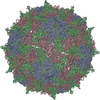+ Open data
Open data
- Basic information
Basic information
| Entry | Database: PDB / ID: 7bgk | |||||||||
|---|---|---|---|---|---|---|---|---|---|---|
| Title | Native virion of Kashmir bee virus at neutral pH | |||||||||
 Components Components | (Structural polyprotein) x 4 | |||||||||
 Keywords Keywords | VIRUS / Viruses / Riboviria / Orthornavirae / Pisuviricota / Pisoniviricetes / Picornavirales / Dicistroviridae / Aparavirus / Kashmir Bee Virus | |||||||||
| Function / homology |  Function and homology information Function and homology information | |||||||||
| Biological species |  Kashmir bee virus Kashmir bee virus | |||||||||
| Method | ELECTRON MICROSCOPY / single particle reconstruction / cryo EM / Resolution: 2.8 Å | |||||||||
 Authors Authors | Mukhamedova, L. / Plevka, P. / Fuzik, T. / Hrebik, D. / Novacek, J. | |||||||||
| Funding support |  Czech Republic, 2items Czech Republic, 2items
| |||||||||
 Citation Citation |  Journal: J Virol / Year: 2021 Journal: J Virol / Year: 2021Title: Virion structure and genome release mechanism of dicistrovirus Kashmir bee virus. Authors: Liya Mukhamedova / Tibor Füzik / Jiří Nováček / Dominik Hrebík / Antonín Přidal / Gerardo A Marti / Diego M A Guérin / Pavel Plevka /    Abstract: Infections of Kashmir bee virus (KBV) are lethal for honeybees and have been associated with colony collapse disorder. KBV and closely related viruses contribute to the ongoing decline in the number ...Infections of Kashmir bee virus (KBV) are lethal for honeybees and have been associated with colony collapse disorder. KBV and closely related viruses contribute to the ongoing decline in the number of honeybee colonies in North America, Europe, Australia, and other parts of the world. Despite the economic and ecological impact of KBV, its structure and infection process remain unknown. Here we present the structure of the virion of KBV determined to a resolution of 2.8 Å. We show that the exposure of KBV to acidic pH induces a reduction in inter-pentamer contacts within capsids and the reorganization of its RNA genome from a uniform distribution to regions of high and low density. Capsids of KBV crack into pieces at acidic pH, resulting in the formation of open particles lacking pentamers of capsid proteins. The large openings of capsids enable the rapid release of genomes and thus limit the probability of their degradation by RNases. The opening of capsids may be a shared mechanism for the genome release of viruses from the family The western honeybee () is indispensable for maintaining agricultural productivity as well as the abundance and diversity of wild flowering plants. However, bees suffer from environmental pollution, parasites, and pathogens, including viruses. Outbreaks of virus infections cause the deaths of individual honeybees as well as collapses of whole colonies. Kashmir bee virus has been associated with colony collapse disorder in the US, and no cure of the disease is currently available. Here we report the structure of an infectious particle of Kashmir bee virus and show how its protein capsid opens to release the genome. Our structural characterization of the infection process determined that therapeutic compounds stabilizing contacts between pentamers of capsid proteins could prevent the genome release of the virus. | |||||||||
| History |
|
- Structure visualization
Structure visualization
| Movie |
 Movie viewer Movie viewer |
|---|---|
| Structure viewer | Molecule:  Molmil Molmil Jmol/JSmol Jmol/JSmol |
- Downloads & links
Downloads & links
- Download
Download
| PDBx/mmCIF format |  7bgk.cif.gz 7bgk.cif.gz | 152.7 KB | Display |  PDBx/mmCIF format PDBx/mmCIF format |
|---|---|---|---|---|
| PDB format |  pdb7bgk.ent.gz pdb7bgk.ent.gz | 118.5 KB | Display |  PDB format PDB format |
| PDBx/mmJSON format |  7bgk.json.gz 7bgk.json.gz | Tree view |  PDBx/mmJSON format PDBx/mmJSON format | |
| Others |  Other downloads Other downloads |
-Validation report
| Summary document |  7bgk_validation.pdf.gz 7bgk_validation.pdf.gz | 1 MB | Display |  wwPDB validaton report wwPDB validaton report |
|---|---|---|---|---|
| Full document |  7bgk_full_validation.pdf.gz 7bgk_full_validation.pdf.gz | 1 MB | Display | |
| Data in XML |  7bgk_validation.xml.gz 7bgk_validation.xml.gz | 35.4 KB | Display | |
| Data in CIF |  7bgk_validation.cif.gz 7bgk_validation.cif.gz | 54.3 KB | Display | |
| Arichive directory |  https://data.pdbj.org/pub/pdb/validation_reports/bg/7bgk https://data.pdbj.org/pub/pdb/validation_reports/bg/7bgk ftp://data.pdbj.org/pub/pdb/validation_reports/bg/7bgk ftp://data.pdbj.org/pub/pdb/validation_reports/bg/7bgk | HTTPS FTP |
-Related structure data
| Related structure data |  12182MC  7bc3C  7be9C  7bg8C C: citing same article ( M: map data used to model this data |
|---|---|
| Similar structure data |
- Links
Links
- Assembly
Assembly
| Deposited unit | 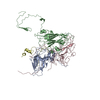
|
|---|---|
| 1 | x 60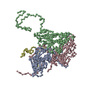
|
- Components
Components
| #1: Protein | Mass: 7066.156 Da / Num. of mol.: 1 / Source method: isolated from a natural source / Source: (natural)  Kashmir bee virus / References: UniProt: Q6SQI6 Kashmir bee virus / References: UniProt: Q6SQI6 |
|---|---|
| #2: Protein | Mass: 23807.529 Da / Num. of mol.: 1 / Source method: isolated from a natural source / Source: (natural)  Kashmir bee virus / References: UniProt: Q80AG2 Kashmir bee virus / References: UniProt: Q80AG2 |
| #3: Protein | Mass: 33335.781 Da / Num. of mol.: 1 / Source method: isolated from a natural source / Source: (natural)  Kashmir bee virus / References: UniProt: Q80AG2 Kashmir bee virus / References: UniProt: Q80AG2 |
| #4: Protein | Mass: 34750.039 Da / Num. of mol.: 1 / Source method: isolated from a natural source / Source: (natural)  Kashmir bee virus / References: UniProt: Q80AG2 Kashmir bee virus / References: UniProt: Q80AG2 |
-Experimental details
-Experiment
| Experiment | Method: ELECTRON MICROSCOPY |
|---|---|
| EM experiment | Aggregation state: TISSUE / 3D reconstruction method: single particle reconstruction |
- Sample preparation
Sample preparation
| Component | Name: Kashmir bee virus / Type: VIRUS / Entity ID: all / Source: NATURAL |
|---|---|
| Molecular weight | Value: 5.932 MDa / Experimental value: NO |
| Source (natural) | Organism:  Kashmir bee virus Kashmir bee virus |
| Details of virus | Empty: NO / Enveloped: NO / Isolate: STRAIN / Type: VIRION |
| Natural host | Organism: Apis mellifera |
| Virus shell | Name: Full virus / Diameter: 350 nm / Triangulation number (T number): 3 |
| Buffer solution | pH: 6 |
| Specimen | Conc.: 2.5 mg/ml / Embedding applied: NO / Shadowing applied: NO / Staining applied: NO / Vitrification applied: YES |
| Specimen support | Grid material: COPPER / Grid mesh size: 200 divisions/in. / Grid type: Quantifoil |
| Vitrification | Instrument: FEI VITROBOT MARK IV / Cryogen name: ETHANE / Humidity: 100 % / Chamber temperature: 277.15 K |
- Electron microscopy imaging
Electron microscopy imaging
| Experimental equipment |  Model: Titan Krios / Image courtesy: FEI Company |
|---|---|
| Microscopy | Model: FEI TITAN KRIOS |
| Electron gun | Electron source:  FIELD EMISSION GUN / Accelerating voltage: 300 kV / Illumination mode: FLOOD BEAM FIELD EMISSION GUN / Accelerating voltage: 300 kV / Illumination mode: FLOOD BEAM |
| Electron lens | Mode: BRIGHT FIELD / Nominal magnification: 75000 X / Nominal defocus max: 3600 nm / Nominal defocus min: 600 nm / Calibrated defocus min: 620 nm / Calibrated defocus max: 3627 nm / Cs: 2.7 mm / C2 aperture diameter: 100 µm / Alignment procedure: ZEMLIN TABLEAU |
| Specimen holder | Cryogen: NITROGEN / Specimen holder model: FEI TITAN KRIOS AUTOGRID HOLDER / Temperature (max): 108.15 K / Temperature (min): 103.15 K |
| Image recording | Average exposure time: 1 sec. / Electron dose: 54 e/Å2 / Detector mode: INTEGRATING / Film or detector model: FEI FALCON II (4k x 4k) / Num. of grids imaged: 1 |
| Image scans | Width: 4096 / Height: 4096 / Movie frames/image: 7 |
- Processing
Processing
| Software | Name: PHENIX / Version: 1.15.2_3472: / Classification: refinement | ||||||||||||||||||||||||||||||||||||||||
|---|---|---|---|---|---|---|---|---|---|---|---|---|---|---|---|---|---|---|---|---|---|---|---|---|---|---|---|---|---|---|---|---|---|---|---|---|---|---|---|---|---|
| EM software |
| ||||||||||||||||||||||||||||||||||||||||
| CTF correction | Type: PHASE FLIPPING AND AMPLITUDE CORRECTION | ||||||||||||||||||||||||||||||||||||||||
| Symmetry | Point symmetry: I (icosahedral) | ||||||||||||||||||||||||||||||||||||||||
| 3D reconstruction | Resolution: 2.8 Å / Resolution method: FSC 0.143 CUT-OFF / Num. of particles: 466310 / Symmetry type: POINT | ||||||||||||||||||||||||||||||||||||||||
| Atomic model building | B value: 27.78 / Protocol: RIGID BODY FIT / Space: REAL / Target criteria: Cross- correlation | ||||||||||||||||||||||||||||||||||||||||
| Atomic model building | PDB-ID: 5CDC Accession code: 5CDC / Source name: PDB / Type: experimental model | ||||||||||||||||||||||||||||||||||||||||
| Refine LS restraints |
|
 Movie
Movie Controller
Controller









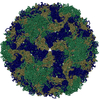
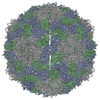
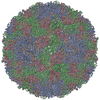
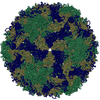
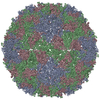
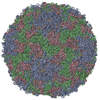
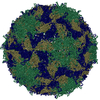
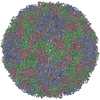
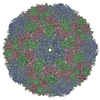
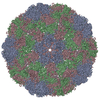
 PDBj
PDBj
